Battle for King of the South.
Atlanta vs. Houston
Although Atlanta and Houston are not rivals like Atlanta and Charlotte, or Houston and Dallas, they still draw comparisons because they are regional powerhouses. Although on paper, the city of Houston dominates Atlanta in population, and Harris County (where much of Houston is located) dominates Fulton County (where much of Atlanta is located) in population, don’t be fooled by what’s counted inside artificial lines (city and county boundaries).
The saying, ‘everything is bigger in Texas,’ doubly applies here, but this is no apples to apple comparison when it comes to determining population and density between these big southern cities. Both Harris County and the city of Houston are huge in square mileage. The latter is a result of Texas having liberal annexation laws compared to Georgia. All told, the city of Houston is nearly five times larger than the city of Atlanta in square mileage and even covers 60 plus square miles more land than Atlanta’s Fulton County.
So, Houston is Bigger, but
As with the other city comparisons, How does Charlotte Compare to Atlanta and How does Atlanta Compare to New York City, this is not a subjective-filled love fest for both cities. It’s all about the hard numbers. In city comparisons, most people think their city is the best. Online forums and travel blogs are peppered with discussions on ‘Atlanta has the worst traffic,’ ‘Houston is more diverse,’ or ‘Atlanta is more beautiful because of the hills and trees, etc.’ I’ve even heard a few Houstonians visiting Atlanta, say that Atlanta is bigger (and faster) than Houston. This is when I break out the Census Bureau figures to show that Atlanta is smaller. I have nothing to refer to how fast Houston is in comparison to Atlanta.
The city of Atlanta is a little more densely populated than the city of Houston, but Houston’s metro area is more than twice as dense as Atlanta’s metro area. Both cities are sprawling monsters, with metro Atlanta gobbling much of northern Georgia, with 30 counties, covering an area roughly the size of Massachusetts. Houston is worse, and it covers an area that’s 1,686 square miles larger than Atlanta’s metro area but doing so with only nine counties.
Here is how Atlanta and Houston compare on basic city demographics:
| Atlanta | Houston | ATL as a percentage of Houston | Houston is this many times bigger than ATL | |
| Population (City) | 498,044 | 2,325,502 | 21.4% | 4.67X |
| Population Density (City) | 3,547 | 3,501 | 101.3% | .99X |
| Population (Metro) | 5,949,951 | 6,997,384 | 85% | 1.18X |
| Population Density (Metro) | 1,350 | 2,978.5 | 45.3% | 2.21X |
| Size in Square Mileage (City) | 134 | 637.4 | 21% | 4.76X |
| Size in Square Mileage (Metro) | 8,376 | 10,062 | 83.2% | 1.2X |
| Median Household Income | $51,701 | $49,399 | 104.7% | .96X |
| Persons in Poverty | 22.4% | 21.2% | 105.7% | .95X |
All Data from U.S. Census Bureau


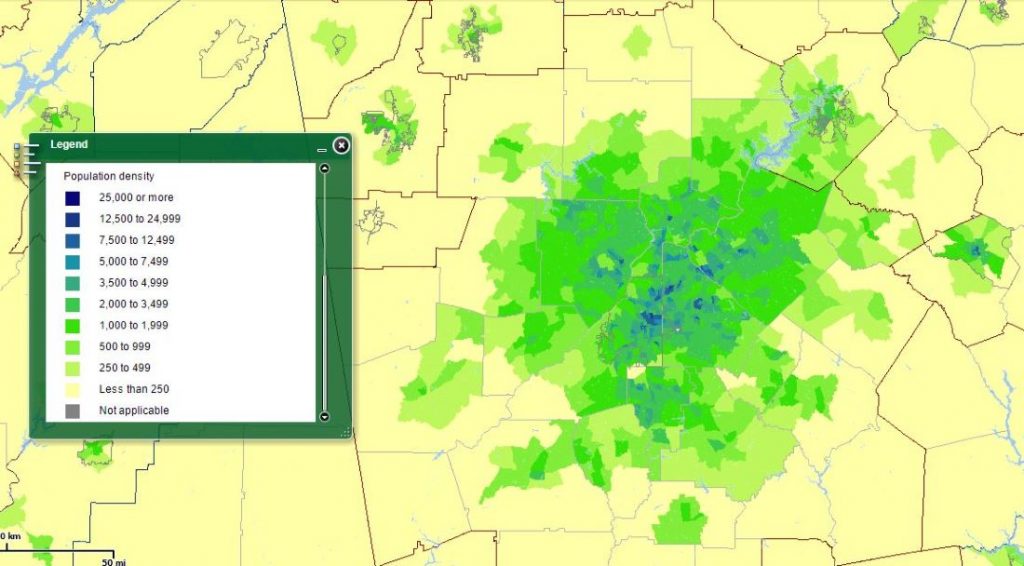
 Atlanta Metro Area Population Density – 2010 Source: U.S. Census Bureau
Atlanta Metro Area Population Density – 2010 Source: U.S. Census Bureau 
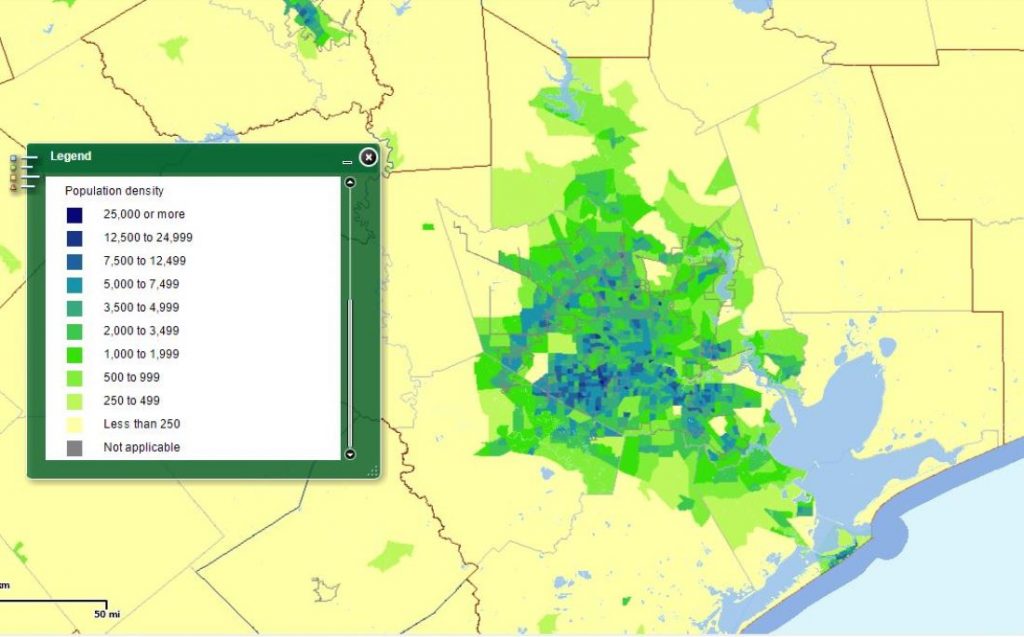
Houston Metro Area Population Density – 2010 Source: U.S. Census Bureau
Public Transit Showdown
So, how does Atlanta compare with Houston on public transit? Both cities, nestled in a region that has been traditionally opposed to major public transit spending and expansion, are still mostly car-dependent.
Metropolitan Atlanta Rapid Transit Authority (MARTA) has existed as an entity since 1971 but opened heavy rail transit service to the Atlanta region in 1979, making Atlanta the first city in the deep south to get such service. Between January and September 2019, more than 87 million unlinked trips were made on MARTA buses and trains, with 56% of these trips on rail.
Metropolitan Transit Authority of Harris County (METRO) opened in 1979, after taking over HouTran, the city-run bus system. METRO opened METRORail, its light rail system in 2004, after a 20-year battle to get rail service in the Houston area. From January through September 2019, more than 67 million unlinked trips were made on METRO buses and trains, with 21% of these trips on rail.
So, Atlanta, head of a region where residents complain about its public transit options, beat out a city with nearly five times the population and more than twice the metro population density.
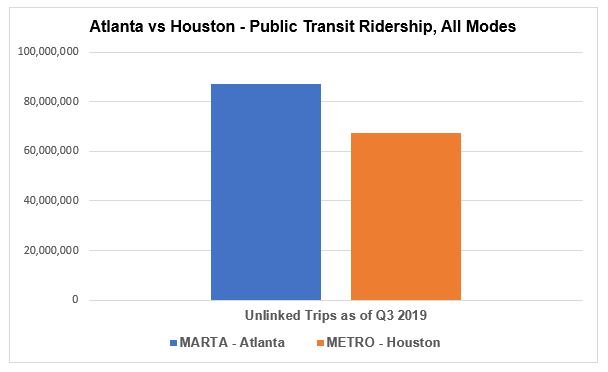

Data source – American Public Transportation Association
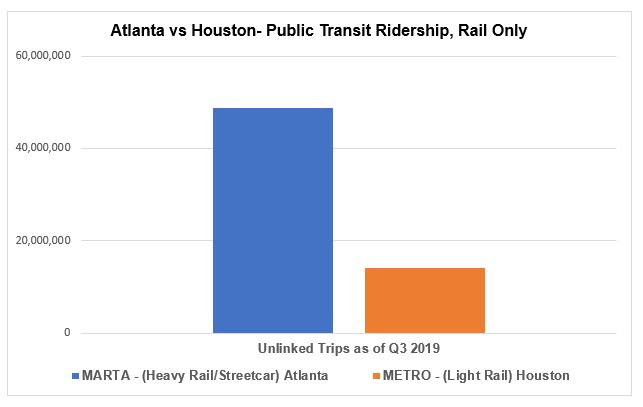

Data source – American Public Transportation Association

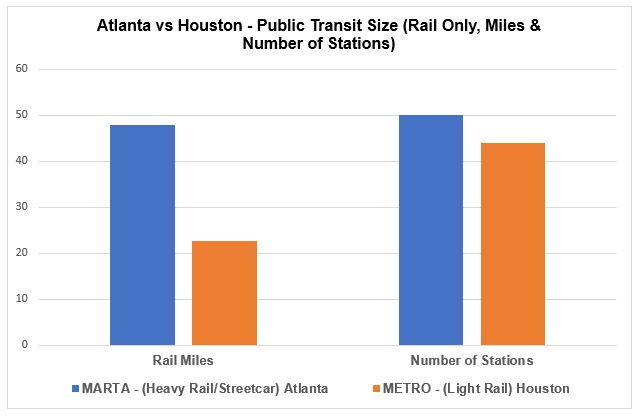
Data source – American Public Transportation Association
Atlanta Skyline vs. Houston Skyline
Skyscrapers and big cities go together like, well skyscrapers and big cities (except for Washington, DC). Atlanta and Houston are big cities with lots of high-rises, and they both have tall buildings in non-traditional areas (also known as edge cities). Atlanta and Houston’s skyscraper game is put to the test by simply looking at the number of skyscrapers, the number of skyscrapers per square mile (skyscraper density), and the top ten tallest in each city.
According to Skyscraperpage.com, Atlanta has 461 buildings 12 floors and higher or 115 feet and higher). Houston has 574 high-rises with 12 floors or 115 feet and higher. These numbers include high-rises in all sub-markets in each city.
| Rank | Top 10 Tallest Atlanta Buildings | Height (Feet) | Floors | Top 10 Tallest Houston Buildings | Height (Feet) | Floors |
| 1 | Bank of America Plaza | 1,023 | 55 | JPMorgan Chase Tower | 1,002 | 75 |
| 2 | SunTrust Plaza | 869 | 60 | Wells Fargo Bank Plaza | 992 | 71 |
| 3 | One Atlantic Center | 820 | 50 | Williams Tower | 901 | 64 |
| 4 | 191 Peachtree Tower | 770 | 50 | Bank of America Center | 780 | 56 |
| 5 | Westin Peachtree Plaza | 723 | 70 | Heritage Plaza | 762 | 53 |
| 6 | Georgia-Pacific Tower | 697 | 52 | 609 Main at Texas | 757 | 49 |
| 7 | Promenade II | 691 | 38 | Enterprise Plaza | 756 | 55 |
| 8 | AT&T Midtown Center | 677 | 47 | CenterPoint Energy Plaza | 741 | 53 |
| 9 | 3344 Peachtree | 665 | 47 | 1600 Smith Street | 732 | 55 |
| 10 | 1180 Peachtree | 657 | 41 | Fulbright Tower | 725 | 52 |
| Atlanta Top 10 Average Height/Floors | 751 | 51 | Houston Top 10 Average Height/Floors | 815 | 58 |
Houston has 113 more high-rises than Atlanta, and when comparing each city’s top 10 skyscrapers by height and number of floors, Houston’s top 10 skyscrapers average 64 feet and seven stories higher than Atlanta’s top 10 average. Skyscraper density is another important factor in measuring skyline intensity. To determine this, I added together with the square mileage of all business districts in Atlanta (Downtown, Midtown, and Buckhead) and Houston (Downtown, Uptown/Galleria and Westchase and divided the total number of high-rises that are only in the business districts, by the total number of square mileage in each city.
The city of Atlanta’s business districts totaled 7.28 square miles and Houston’s, 7.74 square miles. Atlanta has a density of 51 high-rises per square mile, while Houston has 66 high-rises per square mile. Houston is winning in this category with 15 high-rises more than Atlanta per square mile.
The Atlanta vs. Houston Summary
The city of Atlanta is much smaller in size and population than the city of Houston, while the size and population of the respective metro areas are not as far apart. Atlanta’s city core comprises a much smaller part of its metro area (8.37%), while the city of Houston is a larger part of its metro footprint (33.23%). This underlines two things: that Atlanta is a majorly sprawling metro area, and that continuous annexation by the city haven’t been too successful.
If Atlanta’s city population was in the same proportion to its metro as Houston’s city population is to its metro area population, the city of Atlanta’s population would be 1,977,399, about 400,000 residents shy of Houston’s population. This is about the population of Fulton and Gwinnett County combined (1,977,895).
The median household income of Atlanta residents is nearly 5 percent higher than the median household income of Houston residents. Atlanta has almost 6 percent more residents in poverty too. Despite Houston being several magnitudes larger than Atlanta, Atlantans use its main public transit system, MARTA, to the tune of 20 million more unlinked trips than Houston residents do.
At first glance, it may appear that Atlanta’s and Houston’s skylines are similar in the number of tall buildings and high-rise density. Houston’s skyline is a little more built-up than Atlanta in both numbers of high-rise buildings and density.

Are you planning to do a D.C. vs. Baltimore comparision too? I’ll be very intirested in what you will write and say about it.
A D.C. vs. Baltimore comparison would be a great one. I’ll add it to my list of future city comparisons. Thank you!